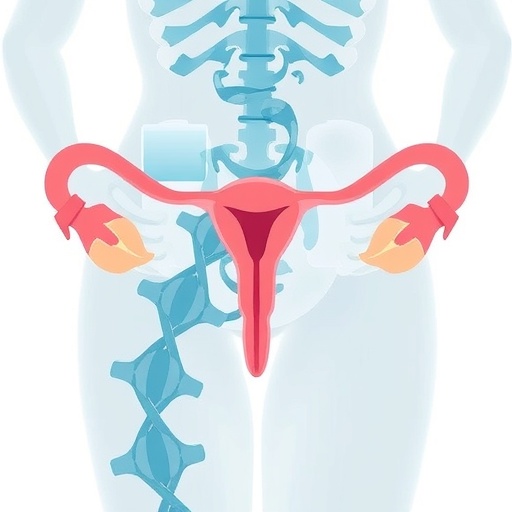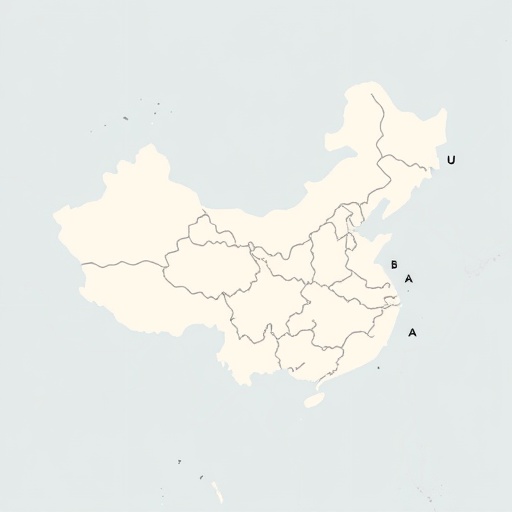In a groundbreaking study published in BMC Pharmacology and Toxicology, researchers from various institutions have unveiled a detailed examination of triclosan, a widely used antimicrobial agent, and its surprising links to endometriosis. This condition affects millions of women worldwide and is characterized by the presence of endometrial tissue outside the uterus, leading to various degrees of pain and infertility. The study, led by Xu, B., Li, M., and Zhao, X., reveals how triclosan’s toxicological properties may contribute to the onset of endometriosis, providing critical insights into the mechanisms that underlie this complex disease.
Triclosan has been a popular ingredient in many household products, including soaps, toothpaste, and even toys, due to its antibacterial properties. However, recent scrutiny of its safety has raised alarms about the potential for environmental and health impacts. This study employs a multi-faceted approach that combines network toxicology, Mendelian randomization, and molecular docking to decipher the biochemical pathways activated by triclosan that may lead to endometriosis. The researchers believe these findings could pave the way for new treatment options as well as regulatory reforms concerning the use of this compound.
The research involves advanced computational analysis to map out the interactions triclosan has with human biological systems. Network toxicology operates on the principle that toxicants can cause biological disruptions by influencing the interaction networks among biological molecules. By highlighting how triclosan interferes with critical signaling pathways, the study demonstrates that exposure to this compound may have long-term implications on reproductive health. Women exposed to triclosan at critical stages of reproductive development are potentially at a higher risk of developing endometriosis, making it imperative to examine the implications of its widespread use.
In addition to conventional observational methods, Mendelian randomization was used in this study to confront the potential biases of traditional epidemiological studies. This powerful tool allows researchers to infer causality from genetic variants associated with exposure to the environmental factor in question—in this case, triclosan. The study suggests that genetic susceptibility can amplify the harmful effects of triclosan exposure, particularly in individuals predisposed to endometriosis, thus establishing a link between environmental chemicals and reproductive disorders.
Moreover, the molecular docking aspect of the research sheds light on the binding affinities between triclosan and several key proteins believed to be involved in endometriosis. Through this method, the researchers can visualize how triclosan molecules interact at the atomic level with target proteins, revealing the potential disruptions in biological function. Understanding these interactions is crucial, as it allows for the development of targeted therapies that might mitigate the harmful effects of this pervasive chemical.
Another interesting facet of this research is its implications in public health and policy. As regulatory agencies reassess the safety of triclosan, findings from this study could inform guidelines and recommendations regarding its use in consumer products. With increasing evidence linking environmental toxins to reproductive health issues, public awareness campaigns may also incentivize companies to find safer alternatives to triclosan, ultimately benefiting consumer health.
The study is poised to stir discussions in both scientific circles and the public domain, prompting a reevaluation of commonly used chemicals. Concerns about pollutant exposure and their correlations to chronic conditions such as endometriosis underscore the need for rigorous research in toxicology and epidemiology. As discussions around toxic chemicals gain momentum, actuating a policy shift from reactive to proactive health measures can become possible, focusing on preventing exposure rather than merely treating its consequences.
Moreover, with the evidence mounting regarding triclosan’s links to endometriosis, it is also vital for healthcare providers to consider environmental factors when diagnosing and treating reproductive disorders. The interdisciplinary collaboration demonstrated in this study highlights the importance of integrating insights from toxicology, genetics, and molecular biology. The outcome of this research establishes a clear narrative that the battle against endometriosis is not just biological but also environmental.
In the long term, some of the study’s implications may extend beyond women’s health to encompass broader environmental issues. The persistent presence of triclosan in wastewater systems and its ability to bioaccumulate in aquatic ecosystems spotlight a critical environmental crisis. The ramifications of chemical pollution are increasingly evident, necessitating comprehensive environmental legislation that addresses these concerns and prioritizes public health.
Furthermore, understanding the mechanisms of action of triclosan raises interesting questions about the development of alternative antibacterial agents. Research efforts may soon focus on designing new compounds that possess similar antibacterial efficacy while mitigating adverse effects on human health and the environment. This approach could lead to innovative solutions, offering a model for responsible scientific inquiry that aligns consumer safety with environmental stewardship.
In summary, the study conducted by Xu et al. represents a significant step forward in our understanding of the link between chemical exposure and reproductive health, particularly in the context of endometriosis. The multifaceted approach utilized provides a framework for future research, urging scientists to continue investigating the relationship between environmental pollutants and chronic health conditions. By fostering a culture of inquiry that prioritizes health, we may soon turn the tide in the fight against diseases linked to environmental toxins.
This research shines a light on a pressing issue that has far-reaching implications for women’s health and the integrity of our environment. As our understanding deepens, it becomes increasingly apparent that the complex interplay between chemicals and biological systems requires coordinated efforts from researchers, healthcare providers, lawmakers, and consumers.
In conclusion, this study’s findings propel the discussion on triclosan to the forefront, emphasizing that our choices impact not only our health but also the environment. As conversations around sustainability and chemical safety grow louder, this research could be a catalyst for change, igniting awareness and proactive measures against chemical exposures that jeopardize health.
Subject of Research: Environmental toxicology related to triclosan and its impact on endometriosis.
Article Title: Mechanistic decoding of triclosan-induced endometriosis via network toxicology, Mendelian randomization, and molecular docking.
Article References:
Xu, B., Li, M., Zhao, X. et al. Mechanistic decoding of triclosan-induced endometriosis via network toxicology, Mendelian randomization, and molecular docking.
BMC Pharmacol Toxicol 26, 191 (2025). https://doi.org/10.1186/s40360-025-01030-x
Image Credits: AI Generated
DOI: https://doi.org/10.1186/s40360-025-01030-x
Keywords: Triclosan, Endometriosis, Toxicology, Network Analysis, Environmental Health, Mendelian Randomization.
Tags: antimicrobial agents and women’s healthbiochemical pathways in diseaseendometriosis pain and infertilityenvironmental impact of triclosanhousehold products containing triclosanMendelian randomization in epidemiologymolecular docking in pharmacologynetwork toxicology and disease mechanismsnew treatment options for endometriosisregulatory reforms on triclosan usetoxicological effects of triclosantriclosan and endometriosis





